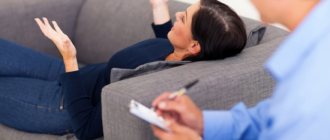The processes of physiological genesis during which the human body and brain rest temporarily include sleep. This happens against the background of a reduced reaction to various external stimuli. Sleep becomes restless when a person is already asleep, and his hard worker brain is actively working. He does not calm down, but ponders various life issues. In such cases, it seems that the person is not sleeping, he is simply awake. This kind of sleep is an inferior phenomenon. When you wake up in the morning, you feel tired, and you don’t have the necessary strength for full work.
Today, this situation happens to many people; it has almost become the norm.
However, a person needs healthy sleep, like air. It is able to restore brain cells and provide a surge of energy, vigor and strength. A poor night's rest or lack of sleep can be detrimental to your health. And this, in the end, will lead to the body aging too quickly.
Classification of startles when falling asleep in adults
Most often, myoclonus occurs for the simplest reasons. For example, after severe physical fatigue. That is, it is not a symptom of a serious illness. Night cramps, or myoclonus, are divided into several types based on the source of localization in the nervous system:
- Stem. They occur when nerve receptors are overexcited.
- Cortical. They are provoked by an external stimulus - sudden noise, bright light.
- Spinal. This type is most often a consequence of inflammatory diseases, heart attacks, tumors, and injuries.
- Peripheral. Consequence of damage to elements of the peripheral nervous system.
Factors that cause myoclonus attacks
In the presence of certain diseases of the body, the causes of myoclonic spasms when falling asleep or during sleep can be:
- Diffuse processes in the gray matter of the brain caused by a whole list of pathologies.
- Neurological diseases of various etiologies.
- Brain hypoxia, or oxygen starvation.
- Uremia. If the normal functioning of the kidneys is disrupted, the body is poisoned by the products of protein metabolism.
- Hyperosmolar coma.
Simpler causes of myoclonus in adults include:
- Excessive physical activity, especially close to bedtime.
- Stress, anxiety, prolonged nervous tension.
- Drinking coffee or energy drinks.
- Nutrient deficiency.
- Tobacco smoking.
Also, attacks of myoclonus occur due to taking certain medications.
Differential diagnosis
The cause of involuntary shuddering when falling asleep can only be determined by differential diagnosis. Modern equipment makes it possible to identify diseases with similar symptoms at an early stage. Only after a full examination, in some cases:
- CT or MRI;
- electroencephalography;
- radiography;
- Ultrasound of the vessels of the cervical spine and head;
- ECHO.
Treatment is prescribed individually.
Theories of involuntary movements
This question remains open. The most common reasons for such movements are given below.
Muscle relaxation
It is believed that during REM sleep, when a person can dream, his arm and leg muscles are paralyzed. But the brain continues to control the state of the body as a whole. For reasons that are still unclear, it happens that muscles relaxed during sleep are perceived by him as something wrong that requires intervention. The brain tries to change the state of the body, to wake it up. Limbs begin to twitch in sleep.
Stress
Also, the cause of involuntary twitching of the arms and legs, trembling of the body during sleep is considered to be a state of stress. Or just an uncomfortable body position on the bed. These conditions do not necessarily lead to the appearance of myoclonus. But the presence of these factors in people increases the likelihood of the syndrome occurring.
If a person tries to sleep after a noticeable nervous disorder, then sometimes the brain suddenly receives a danger signal, for example, the threat of a body falling. The signal is processed and the cause of the danger is sought. At this time, the person is in a state of half-asleep. And, as a rule, I dream about an unexpected fall. When a person wakes up, he usually remembers a dream in which he unexpectedly falls.
Restless legs syndrome
If involuntary and uncontrollable twitching of the limbs while falling asleep occurs regularly over a long period of time, you should consult a doctor. Since in this case, periodic limb movements syndrome may develop. It develops in different ways: in some people it manifests itself during the daytime, without bothering us at all at night.
The result of the development of SPD is a constant interruption of the deep sleep phase, but it does not lead to complete awakening. Therefore, a person does not realize that there is a problem, but the body cannot get proper rest during sleep. In turn, this leads to worsening nervous disorders.
Sleep apnea in adults
Periodic limb movements syndrome is very similar in its symptoms to another movement disorder, restless legs syndrome. These are different pathologies.
The main discomforts associated with restless legs syndrome:
- burning,
- tingling,
- numbness in the legs, including the feet.
Symptoms are relieved for a short time or disappear completely with any movement. Walking, squats, and bending will help remove unpleasant manifestations. The problem is that everything happens when a person is about to fall asleep. Consequently, the quality of sleep decreases. The body again cannot fully rest.
In Parkinson's disease, Huntington's disease, and apnea, involuntary movements of the limbs when falling asleep or during sleep are an almost constant symptom.
In themselves, such shudders or involuntary movements of the limbs do not cause harm. This is only a consequence of processes occurring in the peripheral nervous system, or existing pathologies
Treatment program
Remember that therapy for restless sleep is long and requires patience from the patient. The first thing to do:
- Minimize the time you spend in bed before falling asleep. It is acceptable to spend a quarter of an hour on this, no more.
- Go to bed only when the desire arises. It is worth eliminating daytime naps.
- Get up and go to sleep at the same time every day.
- You can forget about cigarettes and caffeine in the evening. A couple of sips of milk at a pleasantly warm temperature, preferably with honey, acts as a sedative.
- Avoid exercising late at night. Physical activity excites the nervous system. But breathing exercises are very useful.
- A hearty dinner is not for you. A full stomach and sound sleep are incompatible. Drink less fluids at night.
- Learn to relax: lying in a warm bath, through a light massage or listening to pleasant music.
The optimal time for healthy sleep is 7-8 hours. Of course, the pillow and bed should be comfortable, and the temperature in the bedroom should be slightly lower than during the day. If watching TV in bed is a ritual for falling asleep, use it for your health. Remember that walking in the evening never hurt anyone. Fresh air and quiet movement are the best sleeping pills.
So, only the natural rhythm of sleep can be complete. It’s so simple: you need to fall asleep in the evening, wake up in the morning and feel that you got enough sleep! Then the quality of life will improve. Take care of yourself, be in constant mental balance, and your health will definitely be strong!
Other causes of twitching during sleep
The human brain never completely switches off during life. At night it works, but with less intensity. Monitoring of the condition of all organs and processes continues.
Sometimes the slightest muscle contraction is recognized by the brain as a danger signal, and the response signal is aimed at changing the situation. As a result, a person sleeps without waking up at all, but, for example, turns over and changes his position in his sleep. The most common reasons for shuddering in sleep are given below.
Slow breathing
The cause of involuntary movements of the upper body can be a violation of the breathing rhythm. Too few breaths and low levels of air flow create oxygen starvation in the brain. In response, he tries to wake up the body, make the lungs work more intensely.
Intense physical activity during the day
During intense physical activity, lactic acid accumulates in the muscles. It excessively increases muscle tone, resulting in chaotic contractions. Involuntary motor activity at night is manifested by those parts of the body that experienced the greatest load during the day. The person jerks his legs or his whole body.
Mental stress
Often the brain, having received a large amount of complex or negative information during the day, continues to process it at night. But at the same time he will work with greater intensity than usual. This will greatly interfere with falling asleep normally, the person will twitch. All kinds of deadlines and time pressures are fraught with insomnia.
Physiological feedback
The involuntary movements that occur for this reason are almost unnoticed by a person. They do not interrupt the deep sleep phase and do not lead to complete awakening at night. This is a normal process by which the brain controls the state of the entire body during the night's rest. The brain sends signals to the organs and receives a response, while the movements are weak and reflexive.
External stimuli
Normal sleep is possible in silence and darkness. Bright light and sharp sounds provoke the body's sensory systems to send signals of danger to the brain. Therefore, the brain tries to wake up the body.
Circulatory disorders
Night twitching may be caused by poor blood circulation. It occurs as a result of an uncomfortable posture. The second option is the presence of any pathologies. Then involuntary movements during sleep help to increase blood flow and the unpleasant sensations stop.
Types of spasms and twitching
At the moment of falling asleep, the body relaxes, and the brain classifies this fact as dangerous. A sharp muscle twitching becomes a triggering mechanism, a reaction to danger. Excessive muscle tension can also lead to involuntary winces. Convulsions during sleep are of various types:
- synchronous and asynchronous;
- rhythmic and arrhythmic;
- spontaneous;
- reflex.
Experts classify involuntary muscle spasms as
- myoclonic jerks;
- hypnogogic convulsions;
- restless legs syndrome;
- sleep paralysis
Let's figure out what is unique about each type. Is the “shudder and wake up” state dangerous for the body?
Myoclonic jerks
Irregular twitching that does not have a constant location is characteristic of people suffering from epilepsy. It often occurs in older people and is associated
- with neuroses;
- decreased amount of oxygen in muscle tissues;
- age-related degenerative changes occurring in cells.
Muscle contractions can occur in individual parts of the body (legs or arms, facial muscle contractions are possible) or cover it completely. The location of seizures often changes. The danger of myoclonic twitches lies in their ability to progress.
Involuntary muscle contractions (myoclonus) can occur not only at rest, but also during movement.
Hypnogic seizures
This type of involuntary movement, when the legs move when falling asleep, is still being studied. Experts have not come to a definite conclusion about the cause of their occurrence. According to the results of recent studies, it was discovered that involuntary spasms occur when the cervical vertebrae relax at the moment of falling asleep. The nerve fibers leading to the muscles simultaneously become excited, and the person feels a sharp spasm, leading to awakening.
Restless legs syndrome
The phenomenon is typical for middle-aged and elderly people and has a precise location. Unlike previous varieties, the cause of the movements produced is an unpleasant sensation that occurs in the lower extremities: burning, pain. To relieve the feeling of discomfort, a person begins to make involuntary movements with his legs. The disease can progress, and as a result, movements begin to be made with the hands. The syndrome occurs either as a result of acquired health problems or at the genetic level.
Sleep paralysis
This disease phenomenon is distinguished by the fact that the body does not produce sudden shudders, but on the contrary, the person does not have the ability to make them. The brain realizes the need to perform certain movements when waking up, but the body refuses to obey the ongoing impulses. Sleep paralysis does not cause a sudden awakening. Attacks occur only upon normal awakening after sleeping on your back. Doctors believe that stress and an inactive lifestyle are prerequisites for the appearance of sudden numbness.
Did you know that in medieval Europe people were subjected to the Inquisition due to sleep paralysis?
Restoration of motor function will occur when the brain is fully involved in work and is aware of what is happening. At this stage, you can begin to slowly move your tongue, eyes, limbs, starting with your fingers. Having managed to raise your head, you can try more active movements.
Why does a sleeping baby twitch?
If your child's twitches during sleep are repeated frequently and interfere with normal sleep, this is a reason to visit a pediatrician. Good sleep is even more important in infancy than in adulthood. To begin with, parents should observe the child to rule out any everyday causes for such manifestations.
In children, twitching of limbs during sleep occurs very often. There are also ordinary physiological reasons for this, natural for age. But there is also the possibility of developing the disease
In most cases there is no cause for alarm. This is a normal physiological process of a baby getting used to the world around him, to conditions that are radically different from those in which he developed for nine months.
Another reason is that the baby's nervous system is not yet fully developed. The braking mechanisms are not yet fully operational. The transition from the waking state to the sleep state has some difficulties. There are other reasons:
- In premature babies, twitching during sleep occurs more often in the first months of life.
- Very active children have difficulty falling asleep. It is more difficult for their nervous system to calm down.
- If your baby's sleep-wake schedule is disrupted, he becomes overtired and takes much longer to fall asleep.
- The result of dreams. Science recognizes that a child can dream even during the period of intrauterine development. The baby also dreams and may startle from this. Nothing wrong with that.
- Hypnagogic myoclonus. It appears not only in children (usually between 4 and 7 years old), but also in adults. As a result of dreams, in which a sleeping person seems to be falling somewhere or suddenly failing, sharp spontaneous contractions of individual groups of muscle fibers occur. Sometimes this is accompanied by increased heart rate and breathing. After waking up, unpleasant symptoms and feelings of anxiety pass very quickly, without causing harm to the body.
- Pain syndrome. At first, after starting complementary feeding, babies experience colic. This is a normal symptom of the digestive system getting used to a different type of food.
- The newborn often jerks his arms and legs at a very high temperature.
The process of teething is constantly accompanied by pain. This also leads to involuntary twitching during sleep.
Dangerous causes of baby twitching
Myoclonic spasms in childhood may indicate significant disorders in the body:
- Changes in metabolism. Low or high blood glucose levels. Glucose deficiency often provokes seizures.
- Encephalopathy. Brain damage in newborns during labor. Pathology can also be congenital.
- Meningitis. Inflammatory process of the membranes of the brain. Pathology is caused by infections.
- Encephalitis. Infectious disease of the brain.
- Epilepsy. Pathology of the brain, accompanied by frequent spontaneous seizures.
Twitching during sleep causes the baby to wake up
Treatment
It is worth noting that all medications must be taken after diagnosis and identification of the origin of involuntary muscle contractions.
Drug treatment is prescribed only by the attending physician, since there can be many causes of the syndrome.
Anticonvulsants from the Anticonvulsants group occupy the main place in the fight against spasms.
Among the medicines, antiepileptic drugs have proven themselves:
- Barbiturate;
- Clonazepam;
- Volproate;
- Benzodiazapine;
- bioactive supplement L-tryptophan;
- Tryptophan.
How to get rid of myoclonic spasms
In the absence of neurological diseases, the recommendations are simple. Significant physical activity should be completed 3-4 hours before bedtime. Stress should be avoided whenever possible. If you still feel nervous during the day, it is better to take a light sedative in advance.
It is better to take your last meal at least 2 hours before going to bed. The place to sleep should be comfortable. If necessary, it is worth replacing the pillow or mattress or even rearranging the bed for a comfortable night's sleep.
What happens after you fall asleep?
From a scientific point of view, sleep is a complex biochemical process in which many hormones take part. Namely: serotonin, norepinephrine, dopamine, melatonin and some others. In addition, different parts of the brain are involved. For example, the pineal gland is responsible for the production of melatonin [Fundamentals of Psychophysiology, 2003].
In practice, thanks to many years of research, scientists have figured out what exactly happens during sleep. It was possible to determine sleep cycles, phases and different stages. Next we will look at these components in more detail.
The structure of sleep includes certain stages that are repeated cyclically throughout the night. There are two stages of sleep: slow wave sleep and rapid eye movement sleep. The first four stages of sleep occur in non-REM sleep, while the fifth stage occurs in REM sleep.
Schematically, the stages of sleep can be depicted as follows:
| slow sleep | Duration approximately 90 minutes |
| Stage 1 | Lasts the first 5-10 minutes after falling asleep |
| Stage 2 | Lasts for the next 20 minutes |
| Stage 3 | Lasts 30-45 minutes including stage 4 |
| Stage 4 | Very deep sleep |
| REM sleep | Lasts 5-10 minutes per sleep cycle |
This sequence is called a sleep cycle. The duration of the first cycle after falling asleep is approximately 90-100 minutes. Then the cycles are repeated, but with each subsequent cycle the proportion of slow-wave sleep is shortened, while the proportion of REM sleep is lengthened. It is believed that if sleep is complete and a person is healthy, he will have five such complete cycles.
Scientists were able to get an idea of this sleep structure using an EEG (electroencephalogram) device. Studies were conducted on both humans and animals. The data obtained on the rhythm of sleep allowed us to draw conclusions that such alternation is the criterion of “normality”. Those. cyclical repetition of the first, second, third and fourth stages of slow-wave sleep and the following rapid phase.
It was these data that made it possible to define sleep as “a special genetically determined state of the human body (and warm-blooded animals, i.e. mammals and birds), characterized by a natural sequential change of certain printing patterns in the form of cycles, phases and stages” [V. M. Kovalzon, 1999].
Now let's take a closer look at what features and differences each stage of sleep has. First, let's look at the stages of slow-wave sleep:
| 1 | Stage 1 (drowsiness). At this stage of sleep, the subconscious mind generates unusual thoughts, creative ideas that we sometimes wait for while awake, but they do not come. In everyday life, we are used to calling this state drowsiness. It lasts from 5 to 10 minutes. |
| 2 | Stage 2 (light sleep). Here a full-fledged sleep occurs, but it is quite light, because... Some channels of perception are still working. For example, you can quickly wake up from a slight rustle or movement on or near the bed. The stage lasts approximately 20 minutes. |
| 3 | Stage 3 (deep sleep). On it, sleep becomes deeper and there is much less chance of waking up from rustling or quiet sounds. This stage lasts approximately 45 minutes along with stage 4. Both of them are classified as “deep sleep”, while differing in the degree of wave oscillations (less than 50% of delta oscillations - stage 3, more than 50% - stage 4). |
| 4 | Stage 4 (deep sleep). A person sleeps in a very deep sleep and waking him up is much more difficult than in the third stage. Horror or vivid dreams, bouts of sleepwalking or talking in your sleep are typical. However, after such a dream, a person does not remember anything and cannot tell dreams. Deep sleep lasts approximately 45 minutes. |
There is one stage of REM sleep left:
REM sleep:
| 5 | Stage 5. It is also called REM sleep, paradoxical sleep, and rapid wave sleep. Characterized by maximum brain activity during sleep, the subconscious mind works so well that it is in this phase that dreams are remembered. Such a dream lasts 5-10 minutes, and gradually this period increases with each subsequent sleep cycle. |
All stages are equally important for the body, because only adequate sleep contributes to our well-being while awake. In addition, it helps the body’s cells renew, strengthens the immune system, activates cleansing processes, reduces stress and much more, which we will cover in other lessons of our course.









